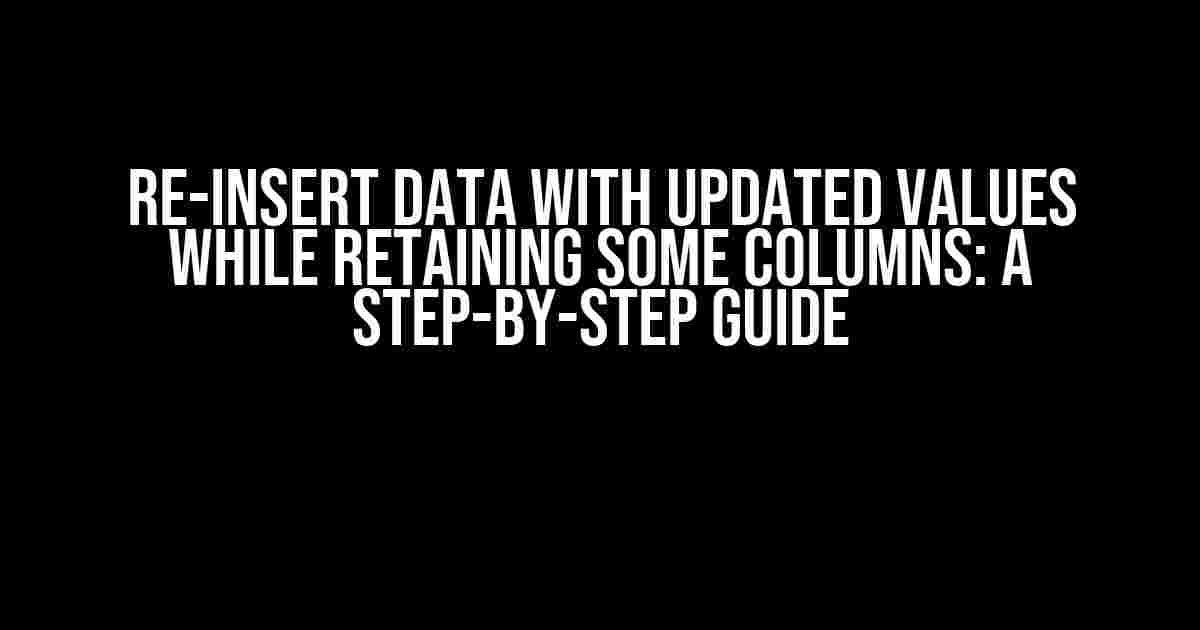Are you tired of manually updating your data and losing crucial information in the process? Do you wish there was a way to re-insert data with updated values while retaining some columns? Well, wish no more! In this article, we’ll show you how to do just that, and it’s easier than you think.
- Why do we need to re-insert data with updated values?
- Benefits of re-inserting data with updated values
- Step 1: Prepare your data for re-insertion
- Step 2: Create a temporary table or spreadsheet
- Step 3: Insert the updated data into the temporary table
- Step 4: Update the original table with the new data
- Step 5: Verify the data
- Conclusion
- Best practices for re-inserting data with updated values
- Frequently asked questions
Why do we need to re-insert data with updated values?
In today’s fast-paced digital world, data is constantly changing. Whether it’s customer information, sales figures, or inventory levels, data is constantly being updated to reflect the latest information. But what happens when you need to update large datasets with new information while preserving some of the original data? That’s where re-inserting data with updated values comes in.
Benefits of re-inserting data with updated values
- Preserves historical data: By re-inserting data with updated values, you can preserve historical data that is crucial for analysis and decision-making.
- Improves data accuracy: Updating data in bulk ensures that your data is accurate and up-to-date, reducing errors and inconsistencies.
- Saves time: Re-inserting data with updated values is a much faster process than manually updating each record individually.
- Enhances data integrity: By preserving original data and updating only the necessary fields, you can ensure that your data remains intact and consistent.
Step 1: Prepare your data for re-insertion
Before you can re-insert data with updated values, you need to prepare your data for the process. This involves:
- Identifying the columns that need to be updated: Determine which columns require updates and which ones should remain unchanged.
- Extracting the original data: Extract the original data from your database or spreadsheet, making sure to include all the columns that need to be updated.
- Updating the data: Update the extracted data with the new values, making sure to preserve the original data in the columns that shouldn’t be changed.
Step 2: Create a temporary table or spreadsheet
Once you’ve prepared your data, you need to create a temporary table or spreadsheet to hold the updated data. This will allow you to re-insert the data into your original database or spreadsheet without affecting the existing data.
CREATE TABLE temp_table ( id INT, name VARCHAR(255), email VARCHAR(255), updated_column VARCHAR(255) );
Step 3: Insert the updated data into the temporary table
Now it’s time to insert the updated data into the temporary table. You can do this using a SQL query or by copying and pasting the data into the temporary table.
INSERT INTO temp_table (id, name, email, updated_column) VALUES (1, 'John Doe', '[email protected]', 'new_value'), (2, 'Jane Doe', '[email protected]', 'new_value'), ...;
Step 4: Update the original table with the new data
Now that the updated data is in the temporary table, you can update the original table with the new values. You can do this using a SQL query or by using a tool like Microsoft Access or Excel.
UPDATE original_table SET updated_column = temp_table.updated_column FROM original_table INNER JOIN temp_table ON original_table.id = temp_table.id;
Step 5: Verify the data
The final step is to verify that the data has been updated correctly. You can do this by checking the original table to ensure that the updated values have been inserted correctly.
| id | updated_column | ||
|---|---|---|---|
| 1 | John Doe | [email protected] | new_value |
| 2 | Jane Doe | [email protected] | new_value |
Conclusion
Re-inserting data with updated values while retaining some columns is a crucial process that can help you preserve historical data, improve data accuracy, and save time. By following the steps outlined in this article, you can ensure that your data is up-to-date and accurate, and that you can make informed decisions based on the latest information.
Best practices for re-inserting data with updated values
- Use a temporary table or spreadsheet to hold the updated data.
- Verify the data before re-inserting it into the original table.
- Use transactions to ensure that the data is updated correctly.
- Test the process on a small dataset before applying it to a larger dataset.
Frequently asked questions
- What happens if I update the wrong column?
- Can I re-insert data with updated values in Excel?
- Is re-inserting data with updated values a secure process?
If you update the wrong column, you can roll back the changes using a backup or by re-inserting the original data.
Yes, you can re-insert data with updated values in Excel using VBA macros or by using the “Update” function.
Re-inserting data with updated values can be a secure process if you follow best practices such as using transactions and verifying the data before re-inserting it.
By following the steps and best practices outlined in this article, you can re-insert data with updated values while retaining some columns with confidence. Remember to always verify the data and use transactions to ensure that the process is secure and accurate.
Frequently Asked Question
Got some burning questions about re-inserting data with updated values while retaining some columns? We’ve got you covered! Check out these frequently asked questions and find the answers you need.
What is the purpose of re-inserting data with updated values?
Re-inserting data with updated values allows you to refresh your data without losing any existing information. It’s an essential step in data maintenance, as it ensures that your data remains accurate and consistent.
Which columns should I retain when re-inserting data?
You should retain columns that contain unique identifiers, such as IDs or timestamps, to ensure that you’re updating the correct records. Additionally, you may want to retain columns that contain data that doesn’t change, such as usernames or email addresses.
How do I re-insert data with updated values in a SQL database?
To re-insert data with updated values in a SQL database, you can use the UPDATE statement with a WHERE clause to specify the conditions for which rows to update. For example: UPDATE table_name SET column1 = ‘new_value’ WHERE id = ‘existing_id’;.
Can I re-insert data with updated values in a non-SQL database?
Yes, you can re-insert data with updated values in a non-SQL database, such as a NoSQL database or a document-oriented database. The process may vary depending on the specific database management system you’re using, but the concept remains the same.
What are some best practices for re-inserting data with updated values?
Some best practices for re-inserting data with updated values include verifying the accuracy of the updated data, using transactions to ensure data consistency, and logging changes for auditing and debugging purposes.




